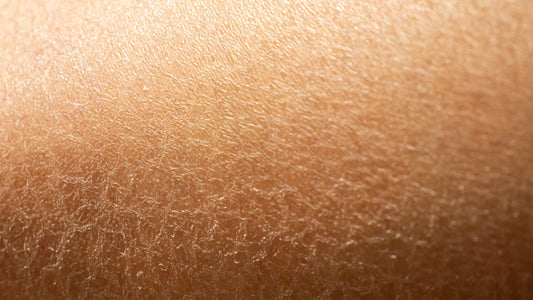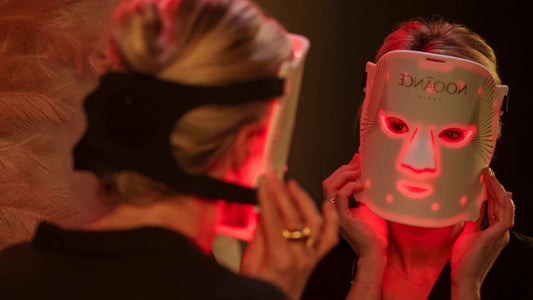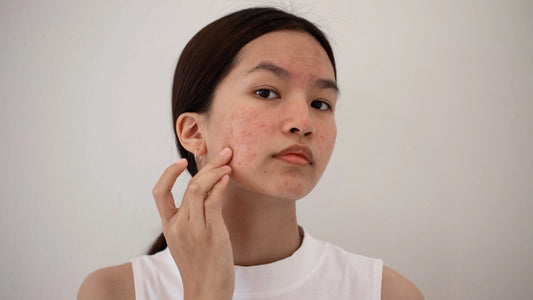Understanding skin aging
Skin aging depends on two factors:
- Intrinsic aging linked to our genetics
- Extrinsic aging linked to the influence of the external environment on the skin.
Intrinsic aging
Intrinsic aging simply corresponds to our biological clock. With age, we observe a slowing down of all skin processes:
- Cell renewal is slowed as well as cell proliferation, this leads to an excess of dead cells on the surface of the skin which can result in a dull complexion.
- The production of the constituent elements of the skin: collagen, elastin, hyaluronic acid decreases, which causes a loss of elasticity, skin sagging and the presence of wrinkles.
- The skin barrier is more fragile, less functional, the skin tends to become drier and dehydrated, which accentuates the presence of wrinkles.
- Melanocytes, which are the cells producing melanin, become less efficient and present abnormalities which result in the appearance of hyper or hypo pigmented spots.
- Subcutaneous adipose tissue atrophies just like muscle masses
These phenomena lead to an overall thinning of the skin and a weakening leading to sagging skin.
Extrinsic aging
Extrinsic aging results from the impact of external aggressions on the skin such as the sun, pollution, diet, tobacco, or even stress and sleep. According to some data, skin aging is 80% dependent on extrinsic aging.
The sun
The sun is the most aggravating factor for the skin. It emits ultraviolet rays which are classified into 3 categories:
- UVC which is stopped by the ozone layer
- UVB rays which penetrate our epidermis causing sunburn
- UVA rays penetrate deeper into the skin and cause accelerated aging.
UV rays cause mutations in the DNA of cells and they stimulate metalloproteinases, which are collagen-destroying enzymes. This results in premature appearance of spots, loss of elasticity, loss of firmness, and the appearance of fine lines and wrinkles. We even talk about photo aging.
Pollution, tobacco and stress also cause an acceleration of skin aging with an increase in the presence of wrinkles and spots.
Concerning diet, we now know with certainty that malnutrition and deficiencies have an impact on the quality of skin and hair. Certain training deficiencies including hair loss. Additionally, heavy alcohol consumption can also increase perceived age.
It is advisable to have a varied, balanced diet rich in antioxidants and it seems that one of the cuisines richest in antioxidants is Mediterranean cuisine. On the other hand, a diet rich in sugars promotes glycation, a chemical reaction resulting from the fixation of sugars on proteins generating glycated proteins which can neither be destroyed nor released from the cell in which they accumulate. This leads to accelerated aging.
How to reduce skin aging?
Sun cream
The best anti-aging ally is therefore sunscreen. It is recommended to apply sun protection with at least SPF30 outdoors to limit accelerated aging induced by UV rays.
And the good news is that it's never too late to start. A study showed that daily use of an SPF30 sunscreen for 1 year helped improve the signs of photoaging in 32 people aged between 40 and 55. In particular, they observed an improvement in texture, clarity, and a reduction in wrinkles and pigment spots following the use of only a daily sun product.
This improvement would a priori be due to the skin's ability to repair itself if we remove the most damaging factor: the sun.
Today there are great sunscreen products, without white marks, without greasy finish, without sticky finish which are pleasant to use for daily application.
NOOĀNCE elegance sun care offers SPF30 protection with very high UVA protection of 50 to minimize the impact of UVA on skin aging. It also offers a mattifying finish so you don't have any shine throughout the day.
###sunscreen-spf-30-moisturizing-non-greasy-very-high-protection###
Anti-aging active ingredients
There are also great ingredients in cosmetics to promote, for example, the production of collagen and preserve the health of the skin.
Retinoids
The retinoid family includes retinol esters, retinol, retinal and finally retinoic acid and its derivatives. Only the forms: retinol esters, retinol and retinal are authorized in cosmetics.
Retinoids help reduce the signs of aging thanks to three actions:
- They preserve the collagen present by inhibiting the destructive matrix metalloproteinase enzymes which are increased by UV
- They stimulate the production of collagen in the skin for firmer skin as well as those of other important elements of the skin, for example glycosaminoglycans, the best known of which is hyaluronic acid.
- They activate cell renewal: dead cells are replaced by new cells for brighter-looking skin
However, it is only retinoic acid that has the ability to communicate with skin cells. This means that to have the beneficial effects retinol must convert in the skin to retinal and then to retinoic acid. The more conversions there are, the more the effectiveness is reduced, so retinol esters have minimal anti-aging action.
Retinoids can have side effects: increased sensitivity, irritation, skin peeling. It is therefore recommended to start with a low percentage retinol by applying it 2 evenings during the week at the beginning. Then it is possible to increase its frequency of use and gradually also increase the percentage of retinol.
For beginner users, NOOĀNCE offers the unifying and smoothing radiance cream which contains 0.1% retinol. While for experienced users, it is possible to use NOOĀNCE anti-aging treatments containing 0.6% or 1% retinol.
###concentrated-anti-aging-night-care-1-retinol-rechargeable###
Vitamin C and derivatives
Pure vitamin C, L-ascorbic acid, is the second super star ingredient in cosmetics with effectiveness also proven by various clinical studies for percentages between 5 and 20%. It provides:
- Antioxidant properties to protect the skin from external aggressions
- Anti-aging properties by increasing collagen production for firmer skin and less visible wrinkles.
However, vitamin C presents some problems:
- It is difficult to stabilize: vitamin C can very quickly oxidize, which reduces its effectiveness. It is possible to stabilize it best by combining it with vitamin E and ferulic acid.
- It penetrates the skin with difficulty: vitamin C being hydrosoluble, that is to say soluble in water, it has difficulty passing the skin barrier made of lipids.
- It can be irritating for certain skins: in fact, to overcome the two problems above, one of the solutions is to lower the pH to a pH around 3.5 which can be irritating for sensitive skin.
In cosmetics, vitamin C derivatives are now used to overcome these various problems. On the other hand, not all derivatives have the same effectiveness and the same studies. The best derivatives are:
- ascorbyl tetraisopalmitate
- ascorbyl glucoside.
- ethyl ascorbic acid
These three derivatives are present at 10% in NOOĀNCE's unifying and smoothing radiance cream where they are also associated with 0.1% encapsulated retinol. This cream is initially used twice a week, then if all goes well it is possible to increase the frequency of use to every other day then every day.
###unifying-smoothing-radiance-cream-vitamin-c-and-tranexamic-acid-rechargeable###
Vitamin B3
Vitamin B3, known as niacinamide, is a vitamin well tolerated by the skin, stable and compatible with all other cosmetic ingredients. It is an ideal vitamin for all skin types.
- It hydrates and strengthens the skin barrier by increasing the synthesis of free fatty acids, cholesterol and ceramides in the skin, which results in a healthier and stronger skin barrier to best protect itself from external aggressions.
- It reduces wrinkles by stimulating the production of collagen for firmer skin.
NOOĀNCE's multi-active serum contains 5% niacinamide which is the percentage studied in the scientific literature. It is used morning and evening after cleansing and is suitable for all skin types to moisturize, soothe and reduce the signs of aging.
###multi-active-moisturizing-plumping-serum-5-hyaluronic-acids###
Peptides
Peptides are relatively new ingredients in cosmetics but they show great promise. Especially since they are very well tolerated. That said, there are lots of different peptides but not all of them have the same properties and the same studies. Peptides are classified into 4 categories:
- Signal peptides : send a signal to cells to increase the production of collagen, elastin, glycosaminoglycan (hyaluronic acid) and fibronectin.
- Transporter peptides : deliver trace elements such as copper and manganese, necessary for healing.
- Neurotransmitter inhibitor peptides : relax the muscles, causing the reduction of expression lines
- Enzyme inhibitor peptides : directly or indirectly inhibit enzymes, unfortunately there are few if any in vivo studies on these peptides.
NOOĀNCE Copper Peptide Youth Serum contains 2% copper peptides in 3 different forms. It is one of the most studied anti-aging peptides and acts as both a signal peptide and a transporter peptide. Thanks to copper, this serum also helps reduce redness and inflammation. In addition, to maximize effectiveness, the copper peptide is combined with 21% of other peptides acting in very different ways on the skin, which makes it possible to best target the different signs of aging.
###multi-active-youth-aerial-eye-balm###


